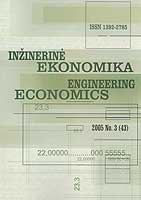Statistical Analysis of Milk Products Consumers’ Behaviour
Statistical Analysis of Milk Products Consumers’ Behaviour
Author(s): Vladislava Bartosevičienė, Linas Gudonavičius, Gintaras ŠaparnisSubject(s): Agriculture, Behaviorism
Published by: Kauno Technologijos Universitetas
Keywords: consumers’ behaviour; statistical analysis; methodology; methods; survey; milk production and milk products;
Summary/Abstract: At the turn of the economy changes (Lithuania rapidly integrating western civilization) new, individual customers’ behaviour model is forming. Referring to scientific research methods, we can understand and forecast customer behaviour, to clarify relation of cause and effect and, having identified customer needs, to produce such product which would meet the needs of current customers and would attract new ones. Understanding of customer and his purchasing process helps to make specific decisions in organising sales, to understand and forecast the priorities of the customer in purchasing process and along with this to increase business opportunities. Because customer behaviour is a constituent of human behaviour, it is difficult to forecast. Therefore enterprises have periodically to carry out the analysis of customer behaviour, allowing understating customer deeds and forecast their future behaviour. In the paper the level of milk and its product consumption in Lithuania and consumption tendencies are highlighted. When carrying this research the methods of complex statistic information collection were used: respondents survey, official statistics data analysis, direct observation of passives, the interview of an informal character. Collected information is analysed and interpreted, causal relations of statistic research structure elements are presented. When carrying out this research, the representative selective analysis (when by special techniques from general set its part which makes sample, and later with the help of statistical methods it is reasonably applied to entire citizens population), was used. By this method it is defined whether provided services have satisfied expectations and met needs. Only fully satisfied customers can become loyal customers of enterprises.
Journal: Engineering Economics
- Issue Year: 2005
- Issue No: 2 (42)
- Page Range: 62-70
- Page Count: 9
- Language: English

